Our editors independently select these products. Making a purchase through our links may earn Well+Good a commission
This Painting Trick Instantly Makes a Small Room Feel Bigger (Which Makes You Happier)
Feeling cramped? Paint your ceiling to match the color of the walls to make a living space look as if it expanded several times its size.

If it frequently seems like the walls of your home are closing in on you, it can make you feel all cramped up. According to Sally Augustin, PhD, an environmental psychologist and principal at Design of Science: “A space that seems appropriately spacious lowers stress levels”—and just as a space can be stressful because it’s too large, the same applies to a space that’s too small. One solution is painting the ceiling (aka the “fifth wall”) to match the color of the walls, which can make a small living space look as though it expanded several times its size. And if you’re curious about how to paint your ceiling, you can DIY. Below, check out a step-by-step guide to painting your ceiling.
Experts in This Article
interior designer based in Los Angeles
Nina Gotlieb is a New York-based interior designer.
environmental psychologist
Tim Malcolm is a home care expert at Hippo.
Can painting your ceiling to match the walls make a room look larger?
Interior designers Nina Gotlieb and Amee Swarz say a little paint goes a long way, but their opinions diverge when it comes to which color can take a room from cramped up to spacious. Gotlieb says that you needn’t shy away from color—painting the room in a single color (also sometimes known as color drenching) can offer visual breathing room. “It tends to make the surfaces recede,” she says, adding that “it makes the things in the space pop, so that the attention is focused more on the things in the room and less so on the shell of the room.”
For those unfamiliar with color drenching, it’s a painting technique that usually involves covering the entirety of the room (with the exception of the floors) in one bold hue or in similar shades of the same color. “You literally drench a room in color, meaning you pick either one single color or maybe just a few different tones that are close to each other and you paint everything—the walls, the trim, the door, and the ceiling,” says Gotlieb, whose own bedroom is painted all green.
Swarz, on the other hand, says that while color drenching can certainly add more interest to a room, she argues that it can make a space feel “cozy”—or, in other words, smaller—as opposed to opening it up. She is of the mind that white or lighter colors are ideal if you want to make a living space look larger. “A lighter color or painting [the ceiling] white would open it up more,” says Swarz.
In any case, Dr. Augustin says that the color you select for a room can have an effect on your mental state. She recommends selecting a lighter color or one with lots of white mixed into it, which can make you feel relaxed. Conversely, Dr. Augustin suggests avoiding overly saturated hues—she states “turquoise blue” and “pumpkin orange” as examples. According to her, these hues not only make a room seem smaller, but they also can make people feel stressed out.
How to paint your ceiling: a step-by-step guide
Whether the walls in your room are covered in color or all white, you might want to paint the ceiling to match—and if you are, check out the step-by-step guide ahead, and allow Tim Malcolm, a home care expert at Hippo, to walk you through the process.
Tools needed for painting a ceiling
1. Drop cloth
Drop cloth keeps floors and furniture paint-free. They are typically made of canvas, a material that can be washed and used repeatedly, or plastic, which is often less expensive than canvas but is more prone to rips or tears.
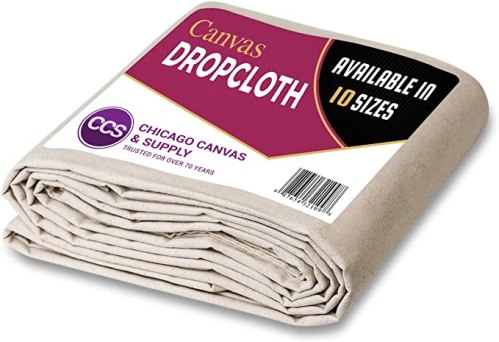
CCS Chicago Canvas & Supply, All-Purpose Canvas Drop Cloth — $18.00
With a 4.7-star overall rating on Amazon after more than 9,000 reviews, this canvas drop cloth is a worthy pick for a DIY paint job. It is machine washable so clean-up is easy, and it comes in nine sizes.
2. Painter’s tape
Painter’s tape helps protect surfaces that you don’t want to paint while allowing you to achieve clean edges. When painting the ceiling, for instance, you might want to use it to mask off the trim and crown molding.
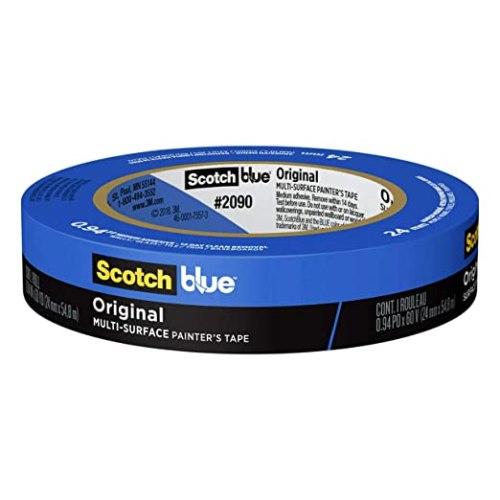
ScotchBlue, Original Multi-Surface Painter’s Tape — $3.00
A popular option among Amazon reviewers, this painter’s tape comes with a near-perfect 4.7-star overall rating after more than 19,000 shoppers chimed in. It has medium-level adhesion to mask off areas you don’t want paint on.
3. Spackle
Spackle patches up small holes and hairline cracks on the ceiling, and Malcolm recommends using a lightweight spackling compound for the job. Just keep in mind that this formula is typically made for minor surface repairs.
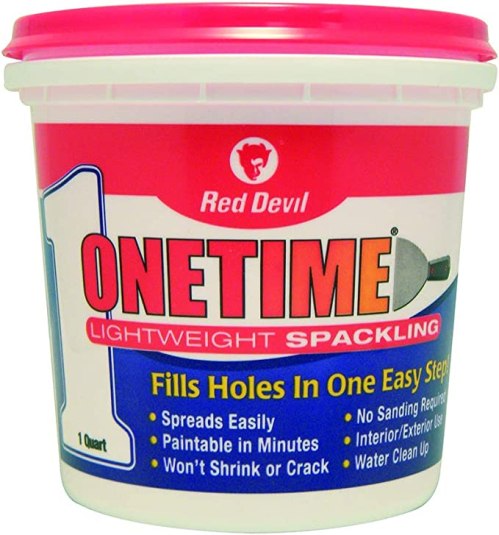
Red Devil, Lightweight Spackling — $10.00
This lightweight spackling compound works to fill in holes and smooth out unsightly cracks. It dries within minutes of application too, so you can paint over it immediately. For a few more dollars, you can purchase it as a kit, which comes with a free putty knife.
4. Putty knife
If you plan on using spackle, you might want to purchase a putty knife. A putty knife allows you to apply spackle where you want it and scrape off any excess. They come in a variety of materials (plastic, metal, or stainless steel) and blade widths, ranging from narrow to wide.

Warner, Plastic Flex Putty Knife — $1.00
If you’re looking for a low-cost putty knife, you can’t go wrong with this option. The blade is made of a flexible plastic, so you can really smoosh the spackle into holes and cracks. It comes in different blade widths, ranging from 1.5 inches all the way to 6 inches.
5. Painter’s caulk
Caulk can seal any gaps and cracks that inevitably develop between two surfaces, such as the drywall and crown molding of the ceiling. There are a wide range of caulk materials available, so it’s important to choose one that’s paintable.

Red Devil, Painter’s Caulk — $10.00
Paintable and resistant to discoloration, stains, and mildew, this caulk is safe to use for interior paint jobs. It goes on white and dries after two hours of application—a feature that many Amazon reviewers love.

Red Devil, Extreme Duty Caulk Gun — $29.00
This tool is made for the precise application of caulk. Simply press down on the trigger to squeeze the caulk of its tube and to stop its flow, just let go of the trigger. According to Amazon reviewers, it’s made the process of applying caulk so much easier.
6. 220-grit sandpaper
Sandpaper smoothens down rough spots, making it necessary if you want to achieve a smooth, professional-looking finish. While you’ll be inundated with options that range in terms of abrasiveness—typically measured in grit—Malcolm recommends a 220-grit variety.

Fandeli, 220-Grit Multipurpose Sandpaper Sheets (25-Pack) — $10.00
These 220-grit sandpaper sheets come in a pack of 25 for under $10. They can be used by hand, plus they’re safe to use on a variety of surfaces. If you are concerned about it being too abrasive to use on drywall, you can also find a 150-grit option by the same brand.
7. Two-inch angled paint brush
Malcolm recommends using a two-inch angled paint brush to paint the perimeter of the ceiling when you apply primer and your first coat of paint. Angled bristles can reach into the nooks and crannies of the ceiling surface, ensuring that no inch is left unadorned.
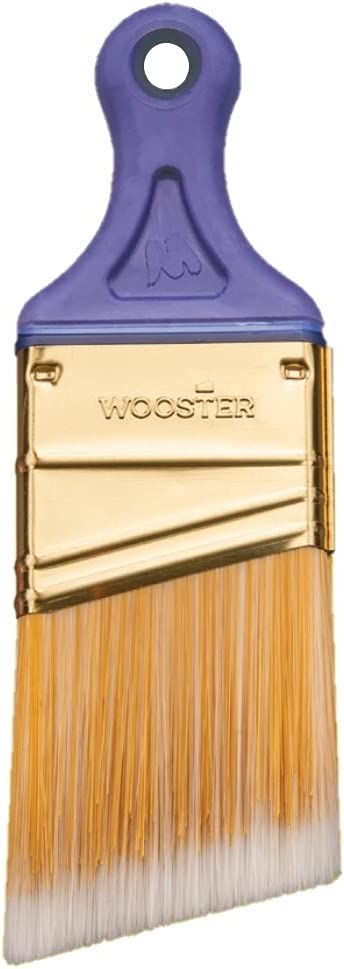
Wooster Brush, Shortcut Angle Sash Brush — $4.00
With a 4.8-star overall Amazon rating after more than 10,000 reviews, this 2-inch angled brush is a popular choice. It is replete with a flexible handle and its synthetic bristles are ideal to use for most, if not all kinds of paint.
8. Paint roller cover
A paint roller can quickly distribute onto large surfaces like the ceiling. Paint roller covers will typically vary in terms of material and the thickness of the nap. A nylon or polyester paint roller cover with a 3/8-inch nap might be ideal for painting drywall surfaces with ceiling or latex paint.

RollerLite, Polyester Knit Standard Roller Covers (6-Pack) — $13.00
Made out of a polyester knit with a 3/8-inch nap, these are a great (and inexpensive option) if you’re looking for a paint roller cover. As a bonus, it comes in a pack of six. Use them with a standard 9-inch paint roller.
9. Paint roller extension pole
The ideal accompaniment to a paint roller, an extension pole allows you to comfortably reach the ceiling. They come in various lengths, but many are also extendable so you can adjust it to the height you need.
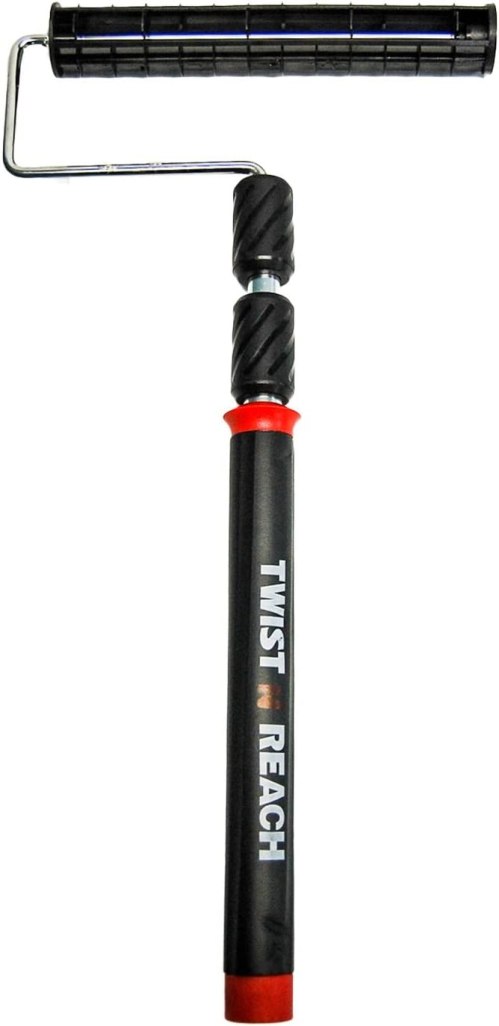
Shur-Line, Twist ‘N’ Reach Premium Extension Pole — $21.00
This extension pole is extendable, reaching up to three feet. It weighs less than half a pound too, making it incredibly lightweight. The cushioned handle keeps things comfortable while the paint roller at the end of the pole is compatible with standard 9-inch roller covers.
10. Paint trays and liners
Paint trays—which are typically made of metal or plastic—hold the amount of paint you want, so you don’t have to dip your paint roller straight into the bucket. You might want to purchase a couple of trays (one for the primer and paint), as well as plastic liners to make clean-up easier.
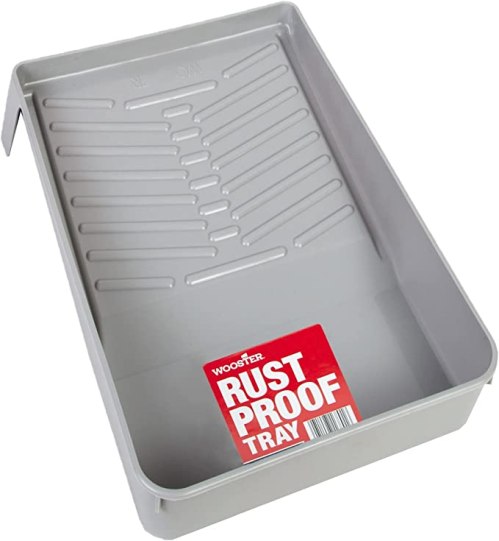
Wooster Brush, Deluxe Plastic Tray — $5.00
Cheap and functional, this paint tray is ideal for holding your primer and paint. It can carry up to one quart of paint, and it even features a grooved surface so you can load an even coating of paint onto a roller cover—and never too much.

Wooster Brush, Deluxe Tray Liner (12-Pack) — $12.00
If you want to extend the life of your paint tray and make clean-up a cinch, consider using a tray liner like these ones. They’re made of plastic, and they come in a pack of 12 for just $12. The disposable liners are compatible with the Wooster Brush paint tray featured above.
11. Six-foot step ladder
When using a paint brush, you’ll likely need a step up to reach the ceilings—and a ladder will come in useful for the task. Malcolm recommends using a six-foot step ladder, which should allow you easy access when painting the ceiling.
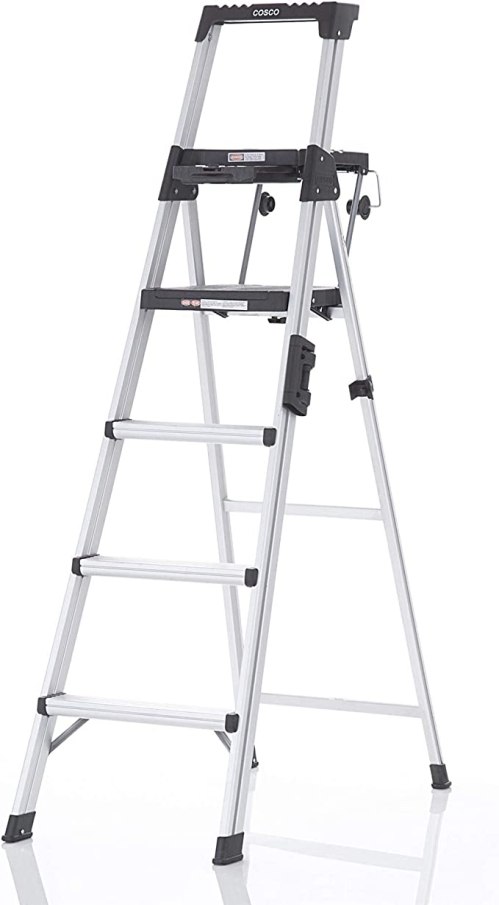
Cosco, Signature Series Step Ladder — $170.00
Made of lightweight aluminum, this six-foot step ladder will give you a sturdy leg up when you paint the ceiling. It also has a tray to store paint and other materials that you might need in a pinch. When you’re done using it, the ladder folds up quickly for easy storage.
12. Primer
Before painting your ceiling in the color of your choice, applying primer is necessary. According to Malcolm, a primer “helps to seal the wall and prevent mold.” Additionally, it can also mask more flaws and prevent any unwanted stains from surfacing after a fresh coat of paint.

Kilz, Multi-Surface Primer, Sealer, and Stain Blocker (1 Gallon) — $24.00
This water-based primer is low odor and leaves behind a mold- and mildew-resistant finish. It hides mild to moderate stains and previously applied colors, offering a clean canvas for paint. The primer takes less than or up to an hour to dry, too.
13. Paint
When selecting paint, it’s important to select one made specifically for the ceilings or choose a latex-based formula. These will not only make the painting process easier, but also give you the best-looking results.
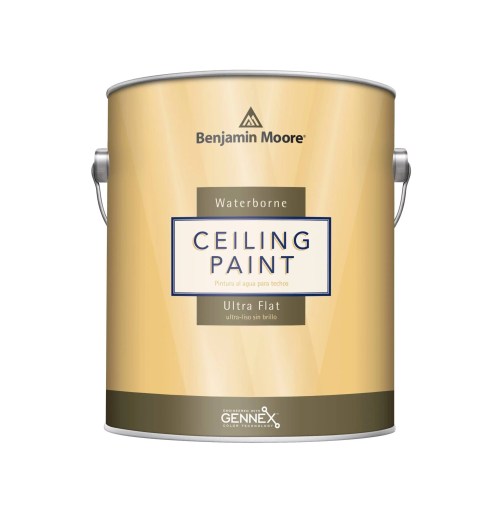
Benjamin Moore, Waterborne Ceiling Paint — $54.00
Both Gotlieb and Swarz recommend paint from the brand Benjamin Moore. “For budget projects, I always go with Benjamin Moore,” says Gotlieb. “They have so many colors to choose from, and they’re all really good colors.” Swarz echoes the sentiment: “I love the colors,” she says, adding,“I love that they are safe.” The option for ceiling paint featured above, like many of Benjamin Moore products, come in zero-VOC, low-odor formulas.

Farrow & Ball, Modern Emulsion Paint — $130.00
If you’re willing to shell out more money for high-quality paint, Gotlieb and Swarz recommend Farrow & Ball paint. “The quality of paint is impeccable,” says Gotlieb, while Swarz says, “Their pigments are exquisite.” The paints from their Modern Emulsion line (featured above) come in a range of colors, from white to neutrals and bold hues, and in a flat matte finish. What’s more, you can use them for the ceiling as well as the walls.
ThirdLove Just Launched Bras That Help Balance Your Body Temperature—Here’s Why That’s a Game-Changer for Women in All Life Stages

These Are the Only Types of Underwear You Should Be Wearing, According to Gynecologists

These Are the Summer Essentials You Should Bring With You Every Time You Leave the House, According to a Derm and an RD

Instructions for painting a ceiling
1. Remove furniture
Relocate as much furniture as possible to another room.
2. Protect the floor and remaining furniture
Cover the floor and the remaining furniture, if any, with drop cloth because the job will be messy. Use painter’s tape over the frame of the door and windows, as well as the ceiling trim and molding to protect against unwanted paint.
3. Patch up cracks, holes, and imperfections
Cover cracks and small holes on the ceiling with a lightweight spackling compound and putty knife, and use caulk to fill any gaps between the drywall and crown molding for a clean finish. Use 220-grit sandpaper to lightly smooth rough patches and remove flaky paint.
4. Clean the ceiling
Wipe down the entire surface of the ceiling to remove dust and debris.
5. Apply primer
Using an angled paint brush, paint the perimeter of the ceiling with the primer. Pour the primer into a lined paint tray and cover the rest of the ceiling with the primer using a paint roller. Let it dry.
6. Sand the primer
Lightly sand the primer. Wipe away dust from the ceiling with a damp sponge and let dry.
7. Paint the ceiling
With a clean paint brush, paint the perimeter of the ceiling surface. Pour paint into a lined paint tray and lightly coat your roller with the paint and with slow and steady strokes, cover the rest of the ceiling. “Aim for multiple coats to cover the ceiling,” says Malcolm.
Frequently asked questions
How can you achieve a clean finish when painting the ceiling?
Malcolm recommends using the proper tools and technique. “Use a roller with an extension pole for more control over excess paint splatter,” he says. “Lightly coat your roller and take slow and steady strokes, aiming for multiple coats to cover the ceiling instead of one heavy coat.”
How can you paint a ceiling without making a mess?
“It’s important to always start by preparing your space,” says Malcolm. “This includes setting down drop cloths, covering furniture and taping exposed edges from moldings to protect them from unwanted paint.” Another pro tip from Malcolm? Use the right paint for the job. “Ceiling paint is thicker and less likely to splatter than wall paint,” he says.
What is the preparation required prior to painting a ceiling?
According to Malcolm, it’s important to inspect the ceiling for cracks, holes, and other imperfections, which a lightweight spackling compound can work to quickly patch up. He also recommends using caulk, which will fill in any gaps between the drywall and crown molding.
Sign up for the Well+Good SHOP Newsletter
Get exclusive deals on wellness, beauty, fitness, and food products that have been hand-picked by our editors.
Got it, you've been added to our email list.







